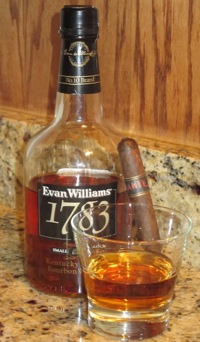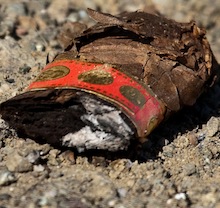Cigar Review: Tatuaje The Mummy
8 Apr 2013
I did a double-take at my local tobacconist the other day when, perusing the Tatuaje selection, I saw a box of “The Mummy†cigars. This smoke is part of Pete Johnson’s Monster Series, a Halloween-inspired limited run that comes out each October—and usually sells out shortly thereafter. Was this my lucky day?
 For whatever reason, I didn’t jump on a box purchase of The Mummy last fall. I assumed I had missed the boat. But maybe I shouldn’t have been so surprised to still see The Mummy for sale in April. Tatuaje produced about 40,000 of them, making it (while still rare) the most widely distributed cigar in the Monster Series to date. The second most prolific Monster Series blends—The Wolfman (2011) and The Face (2010)—were only offered in about half that quantity. They followed The Drac (2009) and the inaugural Monster Series cigar, The Frank (2008).
For whatever reason, I didn’t jump on a box purchase of The Mummy last fall. I assumed I had missed the boat. But maybe I shouldn’t have been so surprised to still see The Mummy for sale in April. Tatuaje produced about 40,000 of them, making it (while still rare) the most widely distributed cigar in the Monster Series to date. The second most prolific Monster Series blends—The Wolfman (2011) and The Face (2010)—were only offered in about half that quantity. They followed The Drac (2009) and the inaugural Monster Series cigar, The Frank (2008).
Some consider Boris to also be part of the Monster Series. Whatever the classification, I consider Boris to be among the finer cigars I’ve ever had the pleasure to smoke (I’ll admit lamenting that I didn’t give that stick a perfect five-stogie rating after recently revisiting it).
Needless to say, given the pedigree of its ancestors, its $13 price tag, and its relative rarity, The Mummy has a lot to live up to. This long, thin cigar (7.75 x 47) boasts a Nicaraguan sun-grown criollo wrapper around Nicaraguan binder and filler tobaccos. Its surface is toothy, moderately oily, and splotched with random areas of dark discoloration. The foot, which emanates notes of cocoa and coffee bean, is unfinished. And while The Mummy is consistently firm to the touch, a punch cut is all that’s needed to yield a smooth cold draw.
Several wooden matches are required to thoroughly establish an even light. Once underway, I’m greeted by woody spice with bitterness on the back of the tongue. This quickly settles into a creamier profile of peanut, white pepper, clove, and dry cinnamon. The smoke production and burn are excellent while the white ash is sandy and overly delicate.
Once these flavors are set, I don’t notice a ton of changes throughout the long smoke, which takes me over two hours to complete. Yet The Mummy sufficiently holds my attention with its medium-bodied complexity and subtlety. What’s striking is how much balance can be achieved with a Nicaraguan puro—a testament to the solid partnership between Pete Johnson and the My Father Cigars factory.
The Mummy may not be the finest, rarest, or most collectible edition in this storied franchise, but it’s certainly worthy of the Monster Series name. Keep an eye out for wooden coffins of 13 cigars (the painted “dress boxes†are much rarer) both online and at your tobacconist. I highly doubt you’ll be disappointed, and I award Pete Johnson’s newest Halloween creation four and a half stogies out of five.

[To read more StogieGuys.com cigar reviews, please click here.]
photo credit: Stogie Guys


 1) Few expected Sam Leccia to stay away from the cigar industry any longer than he was legally obligated to. With the conclusion of his non-compete agreement with the
1) Few expected Sam Leccia to stay away from the cigar industry any longer than he was legally obligated to. With the conclusion of his non-compete agreement with the  Just $15 will land you this bourbon from Heaven Hill Distillery which, in addition to Evan Williams and the eponymous Heaven Hill, also makes Elijah Craig, Old Fitzgerald, Larceny, and Parker’s Heritage, among others. Parker’s Heritage refers to Parker Beam (of the famous Beam bourbon family), master distiller at Heaven Hill along with his son, Craig. Since it’s founding in 1935, Heaven Hill has had a member of the Beam family as its master distiller.
Just $15 will land you this bourbon from Heaven Hill Distillery which, in addition to Evan Williams and the eponymous Heaven Hill, also makes Elijah Craig, Old Fitzgerald, Larceny, and Parker’s Heritage, among others. Parker’s Heritage refers to Parker Beam (of the famous Beam bourbon family), master distiller at Heaven Hill along with his son, Craig. Since it’s founding in 1935, Heaven Hill has had a member of the Beam family as its master distiller. They’re all part of the
They’re all part of the 
 He notes that over the years a number of bourbons have eliminated their age statement (which designates the minimum length of time that the contained spirit aged in new charred barrels), freeing the distillers to combine any combination of straight whiskey and giving distillers increased flexibility to ramp up production more quickly without the cost of longer aging.
He notes that over the years a number of bourbons have eliminated their age statement (which designates the minimum length of time that the contained spirit aged in new charred barrels), freeing the distillers to combine any combination of straight whiskey and giving distillers increased flexibility to ramp up production more quickly without the cost of longer aging. Patrick Ashby
Co-Founder & Editor in Chief
Patrick Ashby
Co-Founder & Editor in Chief Patrick Semmens
Co-Founder & Publisher
Patrick Semmens
Co-Founder & Publisher George Edmonson
Tampa Bureau Chief
George Edmonson
Tampa Bureau Chief